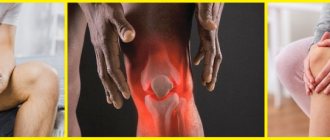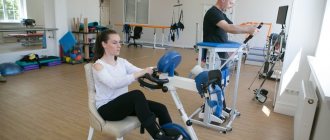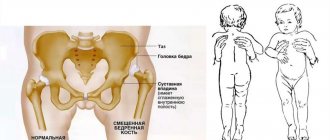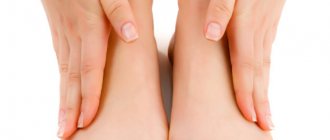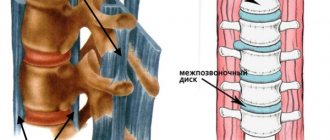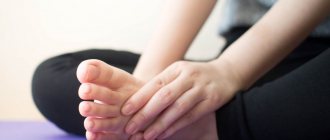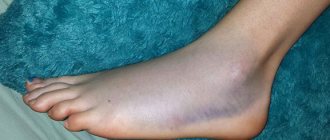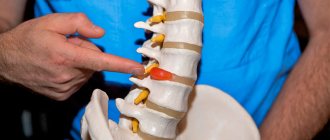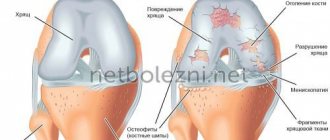Gonarthrosis is arthrosis of the knee joint, a chronic non-inflammatory disease manifested by the progressive destruction of intra-articular cartilage, which is accompanied by abnormal formation of the bones that form the joint, changes in the synovial membrane and synovial fluid.
Gonarthrosis is the most common type of arthrosis. Many people experience knee pain, especially after sitting for a long time without moving, such as after a day of work in the office. It is very likely that gonarthrosis is the cause of such discomfort.
This degenerative disease often develops with age, as stress in the knee, which cannot be avoided in various life situations, inevitably leads to wear and tear of the cartilage over the years. At first, a person feels pain when starting to move after long periods of lying or sitting, but this quickly passes. However, as the disease progresses, knee pain increases and begins to significantly limit a person's ability to move normally in daily activities.
In more than half of the cases where arthrosis affects the knee, both knees are affected at once. In the category of patients from 65 to 75 years old, gonarthrosis is detected in 35% of women and 21% of men.
Causes of gonarthrosis
Healthy articular cartilage in the knee serves a buffering and protective function, acting as a shock absorber during movement and impact. Its presence ensures that the bones of the thigh and lower leg do not directly rub against each other.
It is normal for cartilage to break down due to wear and tear due to the natural aging process. However, under certain circumstances, this wear and tear on the cartilage can become excessive. Increased wear and tear on the cartilage, for example, can be caused by excessive stress on the knees caused by heavy physical work, participation in sports, or being overweight. Improper performance of sports exercises can also have an effect, leading to inadequate (not provided for by the design of the joint) mechanical loads. A separate reason is incorrect positioning of the legs (for example, caused by anatomical pathology), when the knees knock against each other when walking. Gonarthrosis can also develop as a result of joint injuries or bone fractures.
Why do joints begin to hurt with age?
It is believed that with age, serious changes occur in the human body, affecting articular cartilage and leading to changes in its composition and surface, that is, to destruction. As a result, the cartilage becomes brittle and uneven. As a result of the inflammatory process, its gradual destruction occurs.
To maintain the elasticity of cartilage tissue, it is necessary to prevent inflammation, active movements, fight excess weight and drink the required amount of water. If problems arise, it is recommended to consult a rheumatologist.
Symptoms of gonarthrosis
The first symptom of gonarthrosis is pain in the knee. The course of arthrosis at the initial stage can be absolutely painless.
Therefore, the disease often goes undetected for a relatively long time. In most cases, the first symptom of gonarthrosis is knee pain - initially after a long period of inactivity or rest.
Increasing wear and tear of the cartilage increasingly limits the mobility of the knee joint, eventually leading to knee stiffness. At this point, the knee can no longer be bent strongly, and then the leg at the knee can no longer be fully straightened.
If the damage to the cartilage is so severe that the bones begin to rub against each other, the joint may be inflamed. In this case, the joint swells, the skin around it becomes reddish and becomes warm or hot to the touch.
With severe gonarthrosis, the knee joint eventually becomes unstable. When trying to lean on your leg, the knee may suddenly “twist”, which can cause sharp and severe pain. Having experienced this, many people try to "save" the knee by avoiding movement, but this is counterproductive because lack of movement reduces blood flow to the cartilage, which in turn increases the level of cartilage damage.
In advanced cases, the ability to move the joint is completely lost.
Knee pain
The first movements after sitting or lying for a long time seem stiff and painful. The pain begins to subside only a few minutes later or after a few steps. Then freedom of movement in the knee is completely restored. In some cases, a crunching or cracking sound is heard in the knee joint when moving.
As the disease progresses, the knees hurt more and more often. The pain becomes more intense, especially when the knees are subjected to stress during sports or when climbing stairs. In the later stages of the disease, even minor movements can lead to pain that may persist even when the knees are at rest.
More about the symptom
What is weakness and fatigue of the legs
We all know what weakness and fatigue in the legs feels like after prolonged and intense physical activity.
Weakness and fatigue of the legs
However, weakness and fatigue of the legs can also be associated with pathological processes in the lower extremities. Varicose veins play an important role here. In the presence of this pathology, weakness and fatigue of the legs develops much faster, and the usual level of physical activity is no longer possible.
Methods for diagnosing gonarthrosis
In case of constant or recurring knee pain, you should consult a doctor - a surgeon or orthopedic traumatologist. At your initial consultation, your doctor will ask you to describe your symptoms, noting when they began and how they appear. You may have had knee injuries, be sure to tell your doctor about them. Your doctor will then perform a physical examination of your knee using various tests to evaluate the mobility and functionality of the joint.
Instrumental diagnostics
The final diagnosis is usually made on the basis of x-rays. However, subtle wear of cartilage is difficult to notice on x-rays. Therefore, in such situations, computed tomography (CT) or magnetic resonance imaging (MRI) is usually performed.
Sign up for diagnostics To accurately diagnose the disease, make an appointment with specialists from the Family Doctor network.
Diagnostics and prevention
To understand the causes of fatigue and weakness in the legs, you need to contact a number of specialists: orthopedist, surgeon, neurologist, endocrinologist, gynecologist, therapist, cardiologist, rheumatologist. To make a diagnosis, you need to undergo a number of tests:
- blood for ESR and glucose;
- blood for C-reactive protein;
- general urine analysis.
The patient is recommended to visit an ultrasound room, MRI and CT scan, and have an X-ray of the knee joints done. If necessary, a puncture of the joint fluid is prescribed.
When the cause of the disease is determined and treatment is prescribed, a course of painkillers and anti-inflammatory tablets or injections is recommended to relieve symptoms in the knee joint area. Local anesthetics and warming ointments and gels have a good effect.
Systematic weakness and pain in the limbs is a reason to undergo a serious examination. The earlier the causes of changes are identified, the easier and more effective the treatment is, the main task of which is not to relieve symptoms, but to prevent tissue destruction and the development of complications.
Prevention of diseases of the lower extremities and the entire musculoskeletal system comes down to an active lifestyle, proper nutrition, blood pressure control and timely treatment of infections. In this mode, a person can delay the appearance of problems with the musculoskeletal system for many years.
Treatment methods for gonarthrosis
Damage to cartilage is irreversible. This means that gonarthrosis, unfortunately, cannot be cured, so treatment is aimed primarily at relieving pain and slowing the progression of the disease.
Conservative treatment
Conservative treatment may include medications, physical therapy, a weight loss program, habit changes to reduce stress on the knees, and the use of orthotics. Anti-inflammatory and painkillers are used to prevent inflammation and reduce pain. The use of elastic orthopedic bandages can reduce pressure on the joint, and special exercises and physical therapy methods can improve its mobility and strengthen the muscles.
Surgery
Surgical intervention becomes necessary if conservative treatment does not give the desired result. There are procedures to create secondary cartilage tissue in the knee. This can reduce discomfort and, in some cases, eliminate pain altogether. However, the load-bearing capacity of the new cartilage is not as great as the old one. In difficult cases, knee replacement is recommended.
Make an appointment Do not self-medicate. Contact our specialists who will correctly diagnose and prescribe treatment.
Rate how useful the material was
thank you for rating
Medical causes of leg failure in older people
Natural aging of the body causes its weakening, decreased immunity, and deterioration of resistance to various influences, including infectious diseases. Due to accumulated fatigue and multiple stresses, long-term unbalanced nutrition, the stable functioning of various systems and internal organs is disrupted.
Patients over 55 years of age experience an exacerbation of many chronic diseases, and the need for complex therapeutic measures increases significantly. In many age-related or chronic pathologies, characteristic symptoms include numbness, loss of sensation, or failure of the lower extremities.
These include:
- Diabetes. An increased concentration of glucose in the blood provokes accelerated wear and tear of the walls of blood vessels, erosion of bone and muscle tissue. If the patient neglects treatment and does not regularly take medicinal hypoglycemic drugs, damage to the nervous system manifests itself - destruction of the chains of neurons conducting nerve impulses.
- Atherosclerosis. Leg failure in older patients is most often caused by blockage of the vessels of the small pelvis and lower extremities. Initially, the disruption of blood flow is felt as weakness. As the disease progresses, the supply of amino acids necessary for tissue repair becomes insufficient. This leads to their gradual death and dysfunction of the limbs.
- Osteochondrosis of the lower spine. Nerve fibers responsible for the mobility of the lower extremities pass through the lumbar and sacral regions. The disease, which develops with age, leads to pinching of fibers and disruption of the paths of impulses. As a result, sensitivity is lost, the legs partially stop moving, and in severe cases, complete paralysis develops.
- Arthritis. Exacerbation of inflammation can lead to numbness of the fingers and toes in general. When the arthritis itself is treated, the numbness goes away. Since the inflammatory process cannot be completely eliminated, the danger of resumption of such manifestations of the disease remains constant.
- Hemorrhagic stroke. This disease is considered the most dangerous among those leading to numbness and failure of the lower extremities. It is most common among people aged 50+. Hemorrhage can be caused by problems with the blood vessels in the brain, either congenital or acquired. Paralysis of the lower extremities becomes one of the manifestations of the underlying disease. To eliminate it, a set of measures is required to rehabilitate the patient as prescribed and under the supervision of specialists.
Alcoholism
Regular alcohol abuse that lasts for years also causes polyneuropathy. The disease in an advanced state is fraught with partial or complete paralysis of the lower extremities and other unpleasant manifestations:
- Fatigue;
- Cramps of the calf muscles;
- Weakness that does not allow standing on your feet.
Initially, older patients suffering from alcoholism complain of tingling and pain in the legs, gradually developing into numbness. Such patients have many reasons not to seek the help of doctors. This greatly complicates the situation, especially when drinking alcohol continues.
In this case, it is especially difficult for the patient’s relatives. Not only are they trying to fight the underlying disease of a loved one – alcoholism. They also have additional concerns - caring for the patient, servicing him, and an increased amount of housework.
